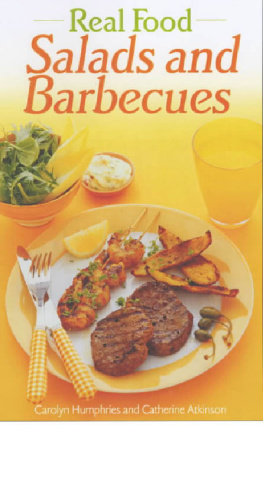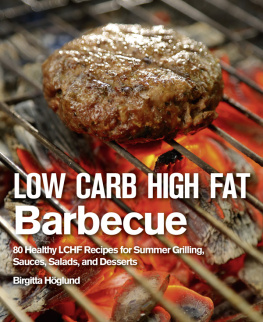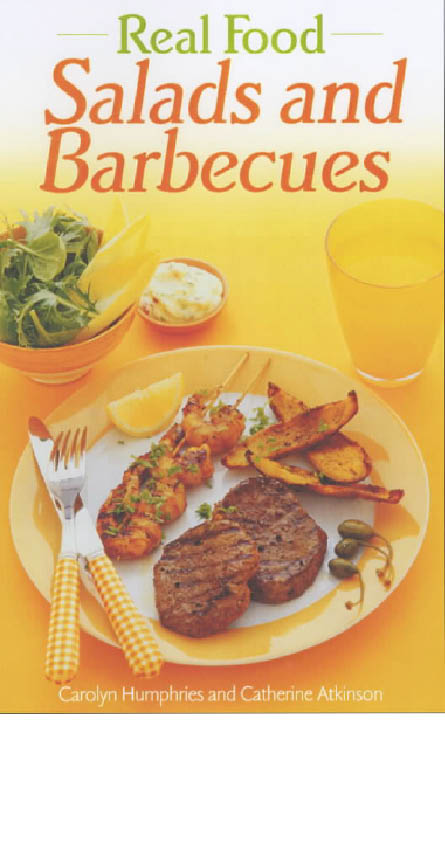by W. Foulsham & Co. Ltd Copyright 2002 and 2012 W. Foulsham & Co. Ltd Cover photograph Peter Howard Smith A CIP record for this book is available from the British Library The moral right of the author has been asserted All rights reserved Print ISBN 9780572027650 Epub ISBN 9780572042899 Kindle ISBN 9780572042882 The Copyright Act prohibits (subject to certain very limited exceptions) the making of copies of any copyright work or of a substantial part of such a work, including the making of copies by photocopying or similar process. Written permission to make a copy or copies must therefore normally be obtained from the publisher in advance.
It is advisable also to consult the publisher if in any doubt as to the legality of any copyright which is to be undertaken. W. Foulsham & Co. Ltd Capital Point, 33 Bath Road Slough, Berkshire SL1 3UF, England www.foulsham.com
Introduction
Theres something special about eating out of doors. The whole ambience of a summer meal is quite different from warming winter fare and if we can cook and eat outside, so much the better, since food cooked on a barbecue has a distinctive flavour all of its own. With the vast selection of fresh, good-quality and even exotic ingredients now available in the supermarkets plus, of course, the imaginative recipes in this book its easy to create delicious and unusual summer dishes to enjoy with family and friends.
What we cannot control, of course, is the weather, so barbecues often have to be impromptu affairs. But with the storecupboard listings in this practical book, and the selection of quick and easy, mouth-watering dishes, you can be ready to react at the first sign of a sunny day. Even when youre not actually barbecuing, you dont need to leave this useful little book on your kitchen shelf, because you can use the great selection of summer salads for all kinds of meals, or just cook the barbecue recipes in your oven or on the grill (broiler). Open a bottle of wine, spread your brightest tablecloth, and youll almost be able to believe you are eating alfresco!
Barbecue Basics
A barbecue simply consists of a container of burning coals with a grate suspended over them to hold the food, but the choice, from simple disposable foil barbecues to pricey gas or electric models, can be daunting. Buy a barbecue that matches your needs but remember its not worth investing in an expensive model if you are going to use it only once a year. Check out the cooking space on the rack, especially if you plan to cook for large numbers, and make sure that you have enough space to store it when the barbecue season comes to an end.
The hibachi (the word is Japanese for firebowl) is one of the most popular and simplest portable barbecues. A grate holds the charcoal just above the base, so that air can circulate beneath through vents and the food is cooked on a rack set above. On the largest versions, enough food can be cooked for 1012 people. Covered kettles are free-standing, round barbecues, which come in several sizes. The rounded metal lid reflects heat all over the cooking area, so the food cooks evenly. Set on a rectangular portable trolley, hooded barbecues are similar to covered kettles in that they can be used covered or open.
They have dampers, which regulate air flow, and movable racks that allow you to control the heat and they often come with extras such as warming racks and rotisseries. At the cheapest end of the market are disposable barbecues , consisting of a ready-to-use tray already filled with charcoal and firelighter. You simply light the charcoal in the tray and wait about 20 minutes for it to get hot. Theyre perfect for barbecue picnics, camping and places where space is limited, such as patios and even roof gardens! With most barbecues, food is cooked over charcoal. In a gas or electric barbecue, lava rock is heated by an electric element or gas flame. The temperature is easy to control and the barbecue only takes 10 minutes to heat up ready for cooking, compared to a standard barbecue, which takes about 40 minutes.
The distinctive flavour comes from the aromatic smoke, which is made when fats and juices in the food drip on to the coals, whether charcoal or lava rock. Barbecue equipment Barbecuing doesnt require much in the way of specialist utensils you can manage with ordinary kitchen implements. However, long-handled utensils make life easier when you are cooking over hot coals. You do need special fuel. Most people find briquettes of compressed charcoal are the best choice. They burn more slowly and at a higher temperature than lump charcoal, although this can light more quickly and so is useful for starting the barbecue.
The following lists contain everything you need to make barbecuing simple and safe. For the fire
- Charcoal or briquettes; firelighters, tapers, matches
- Heavy-duty foil to line the barbecue (it makes it easier to clear up afterwards)
- Tongs for spreading the glowing coals
- A poker for flicking grey ash off the charcoal
- A spray bottle of water to douse flare-ups
- A small shovel for adding coals and for clearing ash afterwards
- Bellows for encouraging the fire if it is dying down
- Sand for dousing the fire after cooking
- A bucket of water, just in case!
- A wire brush and barbecue cleaner for cleaning up afterwards
For the food
- Tongs and spatula with long wooden handles for transferring food to and from the coals and for turning foods
- A basting brush with a long wooden handle and a jug to stand it in
- Kebab skewers long, flat, metal skewers for heavy foods, bamboo and wooden skewers for light, quick-cooking foods (these must be soaked in water for about 1 hour first, to reduce the chance of them charring on the barbecue)
- Hinged wire racks that hold soft food between layers of mesh so that it doesnt break up during cooking ideal for fish, burgers and other similar foods
- Knives, forks, chopping board
- Heavy-duty foil for covering and wrapping food
- Heat-resistant gloves and a large apron
- A trolley or small table for holding plates, uncooked foods, etc.
- Kitchen paper (paper towels) to wipe up any spills and for messy eaters!
For serving
- A serving table
- Crockery and cutlery, including serving cutlery, such as salad servers, tongs and serving spoons
- Drinks and glasses; bottle and can openers; water jug, ice bucket or a coolbox with icepacks to keep drinks cold
- A tablecloth, napkins and finger bowls barbecue eating can be a messy business!
- Condiments and relishes
Barbecue watch points








